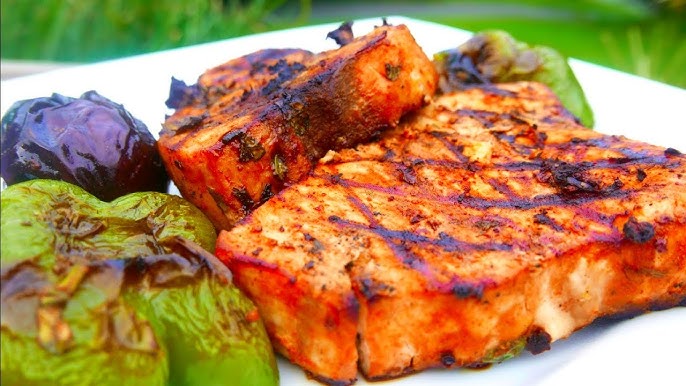Swordfish Steak Recipe: If you’re a seafood lover craving something meaty, juicy, and incredibly satisfying, swordfish is where it’s at. This fish isn’t like your typical flaky white fish—it has a firm, steak-like texture that holds up well to grilling, pan-searing, or even broiling. Think of it as the “steak” of the sea. You get that rich, bold flavor, but with a lightness that only seafood can offer.
Swordfish has a mild, slightly sweet flavor that pairs beautifully with bold herbs, citrusy marinades, or spicy rubs. It’s an ideal candidate for summer barbecues, gourmet dinners, or even quick weeknight meals. One of the reasons chefs love swordfish is because it’s so versatile—whether you’re grilling it on high heat or slow-cooking it in a flavorful broth, the result is always delicious.
What’s more, swordfish is relatively low in bones compared to other fish, making it beginner-friendly. No annoying pin bones to pick through while you eat—just clean, tender meat that slices like butter once cooked right.
Nutritional Benefits of Swordfish
Beyond the great taste, swordfish is packed with essential nutrients. It’s a powerhouse of protein, making it perfect for those who are watching their macros or trying to maintain muscle. A typical 6-ounce swordfish steak offers around 34 grams of protein and just a few grams of fat.
It’s also rich in omega-3 fatty acids, which are known for promoting heart health, reducing inflammation, and improving brain function. You’ll also find a good amount of vitamin D, selenium, and B vitamins—especially B12, which supports nerve health and energy production.
However, like with most large fish, moderation is key due to the potential mercury content. It’s best to enjoy swordfish occasionally rather than daily. Still, when you do choose to cook it, you’re giving your body a nutrient-dense meal that feels like a treat.
Selecting the Perfect Swordfish Steak
Fresh vs Frozen Swordfish
Before you even step into the kitchen, you need to source a quality piece of fish. Both fresh and frozen swordfish can be excellent choices, but they come with their own pros and cons.
Fresh Swordfish: If you’re near a reputable fishmonger or coastal market, fresh swordfish is unbeatable. Look for steaks that are ivory to light pink in color, with a firm, moist texture. It should have a clean, ocean-like smell—not fishy or sour.
Frozen Swordfish: Don’t count out frozen swordfish, though. Flash-frozen at sea, many frozen cuts retain much of the texture and flavor of fresh fish. Just ensure it’s vacuum-sealed and hasn’t developed freezer burn. Thaw it in the fridge overnight for the best results, and always pat it dry before cooking.
One benefit of frozen swordfish is that it’s available year-round, often at a better price. It also gives you more flexibility to plan meals ahead without worrying about spoilage.
Tips on Choosing High-Quality Steaks
Picking the right steak is half the battle. Swordfish steaks should be cut at least 1 to 1.5 inches thick to ensure they don’t dry out during cooking. Avoid pieces that appear dull, dry, or discolored.
Also, keep an eye on the bloodline—the dark reddish-brown section that runs through the center of the steak. A small bloodline is natural, but it shouldn’t take over the majority of the cut. Too much bloodline can have a strong, metallic taste that might overpower the dish.
When in doubt, ask your fishmonger for guidance. A reputable seller will gladly help you pick the freshest, most suitable cut for grilling, pan-searing, or broiling.
Ingredients You’ll Need
Core Ingredients
Here’s the beauty of swordfish—it doesn’t need a ton of extras to shine. The following ingredients form the base of a classic, flavorful swordfish steak recipe:
- 2 swordfish steaks (6–8 oz each)
- 2 tablespoons olive oil
- Juice of 1 lemon
- 3 garlic cloves, minced
- Salt (to taste)
- Black pepper (to taste)
- 1 teaspoon dried oregano or thyme
These are the essentials, and they’re all you really need to bring out the natural beauty of swordfish. Lemon adds brightness, garlic adds depth, and olive oil keeps everything juicy while helping the flavors stick.
Optional Flavors and Enhancements
Want to take things up a notch? Swordfish is super forgiving when it comes to additional flavor:
- Paprika or cayenne pepper – for a spicy kick
- Capers – for a salty punch that pairs well with citrus
- Fresh herbs like parsley, dill, or basil – for a garden-fresh touch
- White wine or balsamic vinegar – to deglaze your pan and make a quick sauce
- Butter – because everything’s better with a pat of butter on top
These extras can help customize your swordfish steak to fit your taste preferences or even match a theme if you’re planning a special meal.
Kitchen Tools and Preparation Setup
Essential Tools for Cooking Swordfish
You don’t need a fancy kitchen to cook restaurant-quality swordfish. Here’s a list of basic tools that’ll make your cooking process smooth:
- Grill or stovetop skillet (cast iron works best)
- Tongs or a fish spatula
- Mixing bowl (for marinade)
- Whisk or fork (to blend ingredients)
- Paper towels (to pat fish dry)
- Instant-read thermometer (optional, but super helpful)
Using the right tools helps you avoid overcooking the fish and ensures a crispy, flavorful crust while keeping the inside tender.
Prepping Your Cooking Space
Before you fire up the grill or heat up the pan, spend a few minutes setting up:
- Thaw your swordfish properly if it’s frozen—preferably overnight in the fridge.
- Dry the steaks thoroughly using paper towels. This is key for a good sear.
- Measure out your ingredients and prepare your marinade ahead of time.
- Preheat your cooking surface—this ensures the fish cooks evenly and quickly.
- Ventilate your kitchen if cooking indoors—pan-searing can get smoky.
Having everything in place will make the cooking process seamless and enjoyable—especially if you’re entertaining guests.
Step-by-Step Swordfish Steak Recipe
Step 1 – Marinate the Swordfish
Marinating your swordfish is where the magic begins. It’s all about infusing those rich flavors into the dense, meaty texture of the fish without overpowering its natural taste. A good marinade adds moisture, enhances flavor, and can even tenderize the meat a bit, although swordfish is already pretty tender on its own.
Here’s a simple and flavorful marinade you can whip up in minutes:
- 2 tablespoons olive oil
- Juice of 1 lemon
- 3 cloves garlic, minced
- 1 teaspoon oregano or thyme
- Salt and black pepper to taste
Combine all the ingredients in a bowl and whisk until well blended. Place your swordfish steaks in a zip-top bag or shallow dish, pour the marinade over them, and ensure each piece is well coated. Seal the bag or cover the dish with plastic wrap and refrigerate for at least 30 minutes—no more than 1 hour, or the acid in the lemon juice could start “cooking” the fish.
During this time, the lemon juice helps brighten the flavors while the garlic and herbs soak into the meat, making every bite pop with taste. The olive oil acts as a carrier, helping all the ingredients blend together beautifully and stick to the fish.
Pro Tip: If you’re short on time, even 15–20 minutes of marinating can make a big difference. Just don’t skip this step!
Step 2 – Preheat and Prep the Grill or Pan
While your fish is marinating, it’s time to set the stage for cooking. Whether you’re grilling outdoors or using a pan indoors, heat is your best friend here. You want your cooking surface hot—not lukewarm. Swordfish needs high heat to get a good sear on the outside while staying juicy on the inside.
If using a grill:
- Preheat the grill to medium-high heat (about 400–450°F).
- Brush the grill grates with oil or spray with non-stick spray to prevent sticking.
If using a skillet (preferably cast iron):
- Place the pan on medium-high heat and allow it to preheat for 4–5 minutes.
- Add a thin layer of oil right before adding the fish.
Why does this matter? High heat ensures you get that beautiful, golden-brown crust. If the pan or grill isn’t hot enough, the fish will steam instead of sear, and you’ll miss out on that texture and flavor.
Make sure you have your tongs or spatula nearby, and don’t overcrowd the cooking surface. Give each steak room to breathe, so it cooks evenly and develops that mouthwatering crust.
Step 3 – Searing the Swordfish to Perfection
This is the step where things start to smell amazing. Take your marinated swordfish out of the fridge and let it come to room temperature for about 10 minutes—this helps it cook more evenly.
Place the swordfish steaks on the hot grill or pan and sear for about 4–5 minutes per side. You’re aiming for a golden crust on the outside and a juicy, opaque center. The internal temperature should reach around 130–135°F for a perfectly cooked steak.
Swordfish is best when it’s not overcooked. Unlike beef, which can be eaten rare, swordfish should be cooked through but not dry. You’ll know it’s ready when it flakes slightly under gentle pressure but still holds together well.
Here’s how to tell it’s done without a thermometer:
- Gently press the thickest part of the steak with a fork. If it’s firm but still slightly springy, it’s ready.
- Cut into the middle and check the color—it should be opaque, not translucent.
If you’re cooking multiple steaks, keep an eye on them. Depending on their thickness, they may not all finish at the same time. Don’t be afraid to adjust your heat slightly if you notice them browning too fast or too slow.
Step 4 – Resting and Plating the Dish
Once your swordfish steaks are cooked to perfection, remove them from the heat and let them rest for 3–5 minutes. This step is crucial—it allows the juices to redistribute throughout the meat, keeping every bite tender and juicy.
While the fish rests, you can quickly whip up a simple sauce using the leftover marinade (boil it first to make it safe) or a fresh drizzle of lemon butter.
Here’s a quick lemon-butter drizzle idea:
- 2 tablespoons butter
- 1 tablespoon lemon juice
- A pinch of salt and chopped parsley
Melt the butter, mix in lemon juice and herbs, and drizzle over the swordfish just before serving.
Plating Suggestions:
- Pair the swordfish with a side of garlic mashed potatoes, grilled veggies, or a fresh garden salad.
- Garnish with a lemon wedge and a sprig of parsley for a restaurant-worthy look.
Presentation makes a difference—serve it hot and enjoy the moment. You’ve just made a delicious swordfish steak from scratch!
Serving Suggestions and Side Dish Ideas
Swordfish is versatile and can be served with a wide array of side dishes, depending on the occasion or your mood. Since it has a mild flavor and a steak-like bite, it pairs well with both light and hearty sides.
Here are some go-to sides for swordfish:
- Grilled Vegetables: Zucchini, bell peppers, asparagus, and red onions are all great grilled options. Brush them with olive oil and season with salt and pepper.
- Rice or Quinoa: A lemon herb rice pilaf or a Mediterranean-style quinoa salad adds a fresh and light contrast.
- Potatoes: Garlic mashed, roasted baby potatoes, or even sweet potato fries complement the savory flavor of the fish.
- Salads: Arugula with citrus vinaigrette, Caesar salad, or a Greek salad with feta and olives make refreshing accompaniments.
- Sauces: Besides lemon butter, try a caper salsa, mango chutney, or even a tomato basil relish.
The goal is to enhance the swordfish without stealing its spotlight. Light, citrusy, and herbaceous flavors tend to work best and can elevate your meal from good to unforgettable.
Storing and Reheating Leftover Swordfish
Swordfish steaks are best enjoyed fresh off the grill or pan, but if you’ve got leftovers, don’t worry—they can still be delicious the next day with the right storage and reheating methods.
How to Store Leftover Swordfish
After your meal, let the leftover swordfish cool down to room temperature—but don’t leave it sitting out for more than 2 hours. Once cooled, wrap the steaks tightly in aluminum foil or place them in an airtight container. Store them in the refrigerator for up to 3 days.
Pro Tip: If you’ve prepared the swordfish with a sauce or marinade, store the sauce separately if possible. This will help preserve the fish’s texture when reheating.
Avoid freezing cooked swordfish if you can. While it’s safe to do so, the texture may become rubbery or dry once thawed and reheated. If you absolutely must freeze it, wrap it tightly in cling wrap and then in a freezer-safe zip-top bag. It can last for about a month in the freezer.
Best Way to Reheat Swordfish
Reheating swordfish can be a little tricky because overcooking it again can turn that beautifully tender steak into something dry and tough. Here’s the best method to keep it moist and flavorful:
Oven Method (Best Option):
- Preheat the oven to 275°F (135°C).
- Place the swordfish on a baking dish and cover it with foil.
- Heat for about 10–15 minutes until warmed through.
- You can add a splash of broth, lemon juice, or a bit of butter to keep it moist.
Skillet Method (Quick Option):
- Warm a skillet over low heat with a small amount of olive oil or butter.
- Reheat the swordfish gently for 3–5 minutes per side.
- Add a lid for a few minutes to steam and re-moisten the steak.
Avoid using the microwave if possible—it tends to dry out the fish quickly and unevenly. If you must use it, keep the heat low and cover the fish with a damp paper towel.
Common Mistakes to Avoid When Cooking Swordfish
Cooking swordfish may seem simple, but a few missteps can turn an otherwise perfect steak into a dry or rubbery disappointment. Here are the most common pitfalls—and how to avoid them.
1. Overcooking the Fish
This is by far the most frequent mistake. Swordfish is a firm fish, but it’s not immune to drying out. Because it’s lean, overcooking it—even by a minute or two—can result in a chewy, unappetizing texture.
Fix: Use a meat thermometer and remove it from heat at 130–135°F. Let it rest to finish cooking.
2. Not Drying the Fish Before Cooking
Moisture is the enemy of a good sear. If you place wet swordfish steaks directly onto the grill or pan, they’ll steam instead of getting that crispy golden crust.
Fix: Always pat the fish dry with paper towels before marinating or cooking.
3. Skipping the Marinade
While swordfish has great natural flavor, skipping the marinade can lead to a bland dish. A quick marinade adds moisture, brightness, and depth of flavor.
Fix: Even a 20-minute soak in lemon, garlic, and oil can work wonders.
4. Using Low Heat
Swordfish needs high heat for a short time. Low heat over a longer time will dry it out and prevent caramelization.
Fix: Preheat your grill or pan until it’s hot enough to sizzle on contact.
5. Not Letting It Rest
Just like with steak, swordfish benefits from a few minutes of resting after cooking. This allows the juices to redistribute, keeping the fish moist.
Fix: Tent with foil and let it rest for 3–5 minutes before serving.
Avoid these mistakes and you’ll elevate your swordfish from basic to brilliant!
Different Variations and Global Twists
Swordfish is like a blank canvas that takes on flavors from all over the world. Whether you’re feeling Mediterranean, Asian, or Latin American, you can tweak the base recipe to match your taste or occasion.
Mediterranean Swordfish
- Marinate with lemon juice, olive oil, oregano, and garlic
- Serve with olives, cherry tomatoes, and capers
- Pair with a Greek salad or couscous
Asian-Inspired Swordfish
- Use soy sauce, sesame oil, ginger, and garlic in the marinade
- Grill and top with green onions and toasted sesame seeds
- Serve with jasmine rice or stir-fried veggies
Latin-Style Swordfish
- Use lime juice, cumin, chili powder, and cilantro for marinade
- Top with a mango salsa or avocado-lime crema
- Pair with black beans and rice
Italian Swordfish Piccata
- Sear the swordfish, then simmer in a lemon, caper, and butter sauce
- Serve with pasta or polenta
- Garnish with fresh parsley and grated Parmesan
Experiment with these regional takes to add variety to your meals and impress your dinner guests.
Health Considerations and Sustainability Tips
Swordfish is healthy and delicious, but like with many seafood options, it’s important to consider both your health and the health of our oceans.
Mercury Content in Swordfish
Swordfish is a large, predatory fish, which means it can accumulate higher levels of mercury compared to smaller fish. This makes it important to eat swordfish in moderation—especially for pregnant women, nursing mothers, and young children.
Safe guidelines:
- Adults: 1 serving per week
- Children: Avoid or limit based on pediatric recommendations
Sustainable Sourcing
Not all swordfish is caught in eco-friendly ways. Some fishing methods, like longline fishing, can harm other marine life, including turtles and sharks.
What to look for:
- Swordfish labeled as “harpoon-caught” or “handline-caught”
- Certifications from the Marine Stewardship Council (MSC)
- Local, wild-caught options from responsible fisheries
Being mindful of where your fish comes from helps protect marine ecosystems and ensures that future generations can enjoy this amazing seafood.
FAQs about Swordfish Steak Recipe
1. Is swordfish safe to eat?
Yes, swordfish is safe to eat when cooked properly. It’s rich in protein and omega-3 fatty acids, but due to its mercury content, it’s best enjoyed in moderation—especially for pregnant women and young children.
2. What does swordfish taste like?
Swordfish has a mild, slightly sweet flavor with a firm, meaty texture. It’s often compared to tuna or even a tender pork chop, making it perfect for grilling or searing.
3. How do I know when swordfish is cooked?
A perfectly cooked swordfish steak should be opaque and flake easily with a fork. The internal temperature should reach 145°F (63°C). Avoid overcooking, as it can become dry.
4. Can I marinate swordfish before cooking?
Absolutely! A simple marinade of lemon juice, olive oil, garlic, and herbs enhances the flavor and keeps the fish moist. Marinate for 15–30 minutes for the best results.
5. What are the best sides for swordfish steak?
Swordfish pairs well with grilled vegetables, garlic mashed potatoes, couscous, or a fresh citrus salad. Light, flavorful sides balance its rich texture.
6. Can I cook swordfish in the oven or pan instead of grilling?
Yes, swordfish is versatile. You can bake it at 400°F for 12–15 minutes or sear it in a hot skillet for 3–4 minutes per side with a splash of olive oil.
7. How should I store leftover swordfish?
Store leftovers in an airtight container in the refrigerator for up to 2 days. Reheat gently to avoid drying it out.
Conclusion
Swordfish steak is one of those dishes that combines elegance with simplicity. With its meaty texture, subtle flavor, and versatility, it’s the perfect way to upgrade your seafood game. Whether you’re grilling for a summer barbecue, cooking a romantic dinner at home, or simply want a healthy, satisfying meal, swordfish delivers.
Follow the steps in this guide—selecting quality fish, marinating with care, cooking with high heat, and avoiding common mistakes—and you’ll end up with a restaurant-worthy dish every time. Don’t be afraid to experiment with global flavors and serve it alongside your favorite sides. Once you try it, swordfish might just become your go-to seafood dish.



